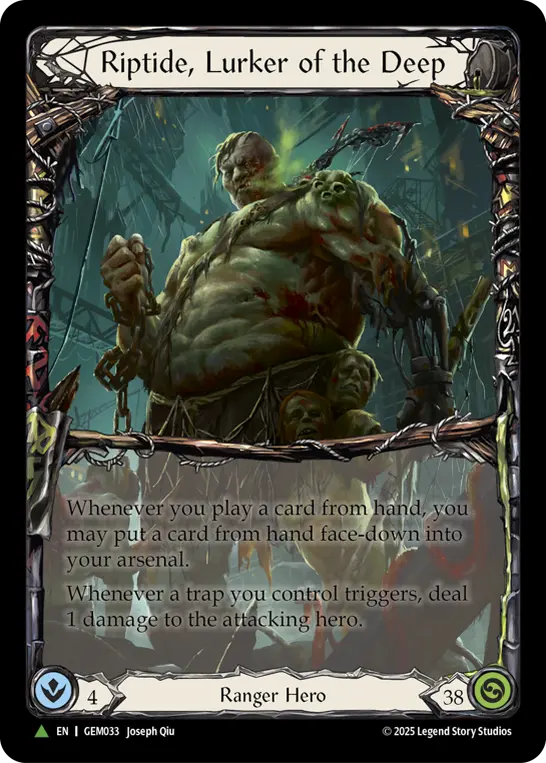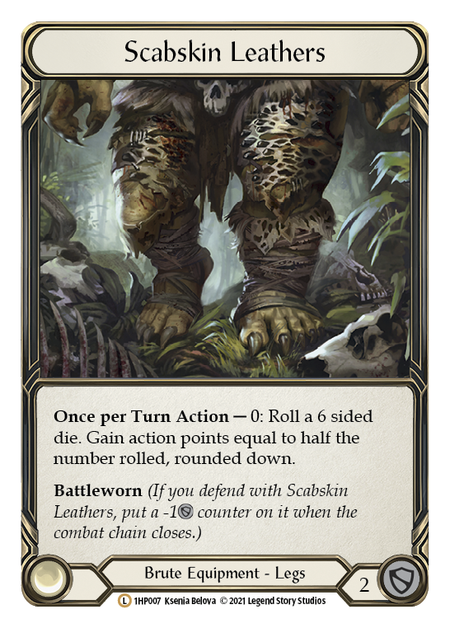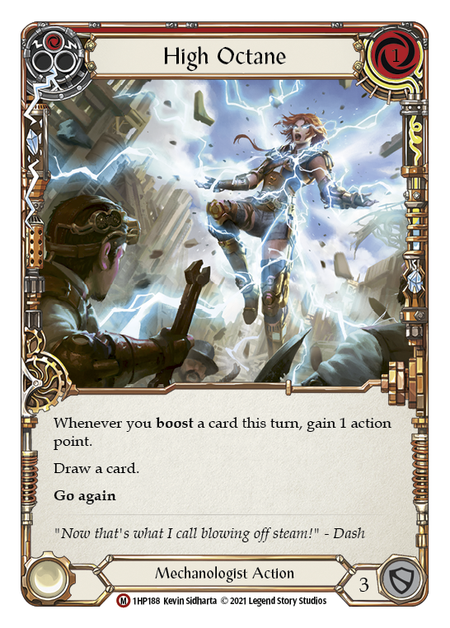With ProQuest season around the corner and Dromai poised to LL, this might be the perfect time to pick up a new hero. Maybe a hero no one will expect. Maybe someone… off-meta?
Grinding events with an off-meta hero has its advantages, but it’s also not for the faint of heart. I would know: I have literally only played Riptide for the past year. Save for a handful of casual blitz games, I have only piloted Riptide at CC events, from Armories to Callings.

This March, I went to a whopping 4 Road to Nationals, an AGE Open, Calling: LA, and all the various Pro Tour: LA side events. I had 5 straight weekends of tournaments culminating in my first top 8 showing at the March AGE Open. All of it on my favorite bloated green boy.
If you’re looking to do something similar with a hero that makes people raise an eyebrow, then this guide is for you. This is everything I’ve learned about grinding off meta heroes, distilled to 10 - well, technically 11 - steps.
Step #0: Define Your Goals
Before you start on your off-meta journey, it’s important to identify why you want to grind an off-meta hero. There are a number of good reasons, and each will impact your approach to the season. Maybe you want to…
- Make a name for yourself
- Have fun
- Try something new
- Catch opponents by surprise
Personally, I play Riptide because I enjoy the hero’s play style and I want to make a name for myself. Notably, I don't value the surprise factor, so I'm willing to stick with a deck that's working, refining and running it back, instead of bouncing between aggro/fatigue to catch people off guard.
The goals define the approach.
Step #1: No One Is Coming To Save You
Maybe “no one” is an overstatement, but off-meta heroes don’t have the same level of attention put towards them as the top decks. If a hero is performing well, there are thousands of people thinking about how that deck operates: how to pilot it, how to beat it, and how it fares into the meta. For off-meta heroes, this might only be a handful of people, with various levels of overall game experience.
This means that your hero is not solved. There might be a favored list, but there is plenty of room innovation. Try everything! Who knows, you may be that one player that finds the game-winning combo!
Of course, this is still easier with the help of the community, which brings us to our next step.
Step #2: Find Your Community
If there are only a handful of people actively working on a hero, then you need to find those people. Connecting with like-minded players will give you an opportunity to get into the weeds. This isn’t just discussing archetypes or basic play patterns, but breaking it all down to single copies of single cards. What parts are crucial? What can be seasoned to taste? What are the different players' approaches? How does that impact their play and matchups?
For example, one of my closest fellow Riptide players is Joseph Cicchini (who wrote some of the first Riptide articles for The Rathe Times). We spent the better chunk of a year picking apart every single possible card, interaction, and deck type for Riptide. As we settle on lists, a familiar pattern emerged: Joseph is inclined to run playsets, valuing consistency, while I tend to play more 2-ofs or 1-ofs, valuing flexibility. We’ve had similar results overall, and our lists are just a few cards apart from each other, but these subtle differences show where there’s flexibility in a deck.
Ever the survivalist, Riptide finds a path forward with this Pox-focused build for Classic Constructed.
by: Joseph Cicchini
Step #3: Practice, Refine, Cut, Trim, Adapt
Grind some games! Whether that’s online through sites like Talishar.net, at your local armories, kitchen table with your friends, or the first RTN of a season. This is the time to find what works and what doesn’t. Is there a card that you’re always happy to see? That’s a good sign you should keep it around. Anything that you’re always disappointed to draw? Cut it!
The practice is important here too. Play against a wide variety of decks, especially your toughest matchups. Becoming aware of the various intricacies between your hero and each other deck will be crucial as you continue the grind. You never know what you’ll see in a round; you’re not the only off-meta hero, after all…
Step #4: Don’t Tilt (You Will Lose)
Look, you’re playing an off-meta hero. There is a reason your hero is off-meta. If it was easy and good and had tons of favorable matchups, everyone would be playing it. You will lose. A lot. It’s part of the process, which is why it has its own step.
The important thing is not to tilt. You need to keep a positive, constructive energy so you can start turning those losses to wins.
With off-meta heroes you are often playing a non-optimal deck, whether that’s due to the available card pool or where you’re at in the process. This means that there is very little room for mistakes or misplays. Some losses will be because of bad matchups, some will be from deckbuilding, but a good amount of them will be misplays that you can’t come back from. Learn from each and every one of those losses.
Step #5: Learn From Your Losses (and Be Honest).
Losses aren’t doing you any good if you aren’t learning from them. I highly recommend taking notes after each game, while it’s still fresh. I typically keep track of my life on a 3x5 note card. After the game is done, I flip it over and write my post game notes. What worked? What didn’t? Why did I lose (or win) this game?
The most important thing here is to be honest. You’re not doing yourself any favors by blaming everything on luck or rough matchups.
Did you make a big misplay? Took a risk you knew you shouldn’t have? Maybe you had a decisive victory, but your opponent rolled 1’s on Scabskins or boosted away their High Octanes. Luck is a big part of any card game. It’s important to identify when it helps you win just as much as when it costs you the game.
For more on evaluating luck, I highly recommend Alex Truell’s article The Skill of Luck.
Let's give credit where credit's due: not all luck is created equal - and make no mistake, some players do create luck.
by: Alex Truell


I find that taking these post-game notes helps me not only in the long run, but in the round-to-round of that day as well. My first RTN this year was at Tabletop Tavern, and I had lost the first three rounds, most of which were favorable matchups. This was also coming off the heels of a 1-5 showing at the February AGE - my one win being a bye in the final round. I was on a huge losing streak. While taking notes for that 3rd round at the RTN, I noticed I was cracking my equipment and using power cards too early. My pacing for this fatigue Riptide list was all wrong. I noted it and made a conscious effort to change that in the upcoming games. I ended up winning the next two rounds against some my toughest matchups: Bravo and Teklovossen.
Step #6: Refine, Refine, Refine
Now that you have your notes from a tournament, it’s time to refine again! Building and piloting decks is an iterative process. As metas change and you hone in on what’s working, you’ll see your deck evolve. That’s a good thing!
My fatigue Riptide list started with 9 Salvage Shots and every defensive card I could muster. Then it shifted as I cut the Salvage Shots in favor of some more nuanced recursion cards like Give & Take and Warmonger’s Recital. Then, we made further shifts cutting Recital to add more go again like Ravenous Rabble and Sic ‘Em Shot.
Each of these changes were made to address our losses. We were consistently winning into Brutes and Ninjas, but losing into slower decks like Guardian. The solution was to add more go-again to present awkward breakpoints. We kept the defensive properties, maintaining our favor into aggro matches, but slowly tuned it to fare better into classes like Guardian or Warrior.
This is why the notes are important. Knowing why you are winning or losing certain matchups will give you the perspective you need to make these kinds of shifts.
Step #7: Don’t Tilt!
Yeah, this step is so important it’s on here twice! Arguably, it’s more important at this stage. After refining for the second or third (or fourth or fifth…) time, you might feel like you are owed some victories. Remember, you are still playing an off-meta hero. While losses are frustrating, each one is a learning opportunity. Keep your head high, learn what you can from it, and take that with you into your next game.
Step #8: Keep What Works
As you continue on this journey, you’ll find yourself winning more. A lot of this will be because you are starting to understand your matchups. You know your deck intimately at this point, every card is a card you chose to be there. This is when playing an off-meta hero plays to your advantage: opponents won’t know what’s coming, especially if your build is doing something different than what people have come to expect from the hero.
As recently as the April AGE, just a month after I Top 8’d with my hybrid Riptide list, I won my final game of the day because a Prism sideboarded wrong, expecting me to play a more well-known aggressive Riptide list. At a major tournament, a win is a win! The surprise is part of the payoff for all this work.
Step #9: Profit!
Hopefully, if all goes well, this is when you can see some important wins. The armory wins, the Top 8s, the qualifications. It won’t happen overnight, but that’s why you keep at it.
My first ever Top 8 was at the March AGE Open, exactly 1 year after Riptide’s debut at the Outsiders prerelease. It was a long journey to get there, filled with lots and lots of losses; but now I’m in a spot where I'm consistently placing top 12 at these Southern California events. As of writing this, I am 5th place in this year’s standings for the AGE Open series. At Pro Tour:LA, I broke even in every single event I played.
While that might not be as impressive as a bunch of wins and gold foils, it shows I’m making progress. Consistency in a card game is extremely valuable. If you can get your deck and your playing to consistently perform, then you are just a few lucky gem pairings away from a win.
Step #10: Repeat
But that’s enough celebration: there’s a new meta right around the corner! Heroes LL, new sets release, new deck archetypes are brewed. Sometimes things will shift so drastically that you’ll need to start at the drawing board. Be prepared for this! You may have to cut your favorite cards or change archetypes entirely to slow down or speed up your deck.
Just remember, you got this. After all, you’ve done this before.






